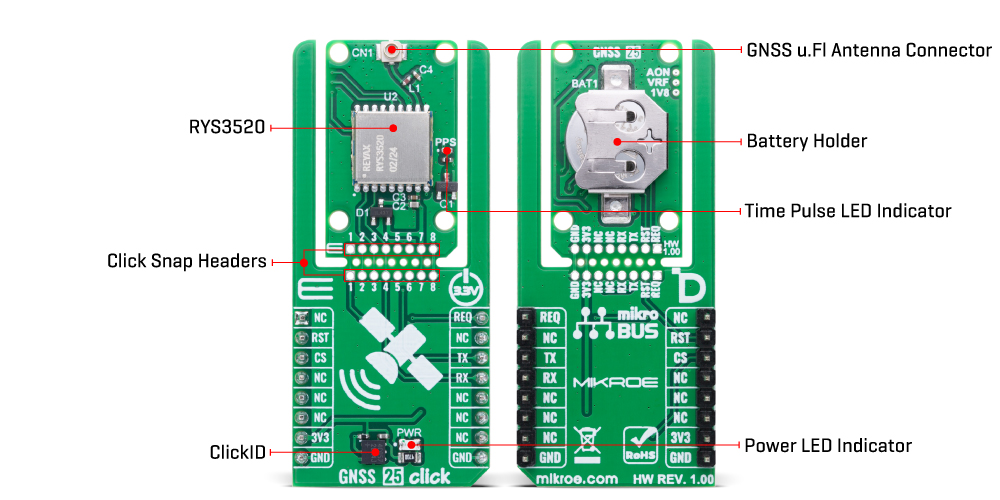OFF
GO LOCAL
| Company | Stock | Price |
|---|---|---|

MIKROE-6535
19 g
Status:
GNSS 25 Click is a compact add-on board designed for accurate and reliable location tracking in embedded applications. It is based on the RYS3520, a multi-GNSS module from REYAX, known for its high sensitivity and performance. The board supports multiple satellite systems, including GPS, GLONASS, Galileo, BeiDou, and QZSS, and operates over several frequency bands to ensure compatibility and precision. It features SBAS support, a 12 multi-tone interference canceller, enhanced SAW filter, LNA, TCXO, and UART communication with a default baud rate of 115200bps. Thanks to the Click Snap feature, size, weight, and power consumption can be reduced for final-phase prototyping. The board also includes a PPS LED indicator, a u.Fl antenna connector, and test points for RF integration. GNSS 25 Click is ideal for automotive navigation, drones, asset tracking, wearable devices, and other systems requiring stable and precise global positioning.
GNSS 25 Click is fully compatible with the mikroBUS™ socket and can be used on any host system supporting the mikroBUS™ standard. It comes with the mikroSDK open-source libraries, offering unparalleled flexibility for evaluation and customization. What sets this Click board™ apart is the groundbreaking ClickID feature, enabling your host system to seamlessly and automatically detect and identify this add-on board, alongside a Click Snap feature introducing a new level of flexibility and ease of use.
This product is no longer in stock
Availability date:
OFF
| Company | Stock | Price |
|---|---|---|

GNSS 25 Click is based on the RYS3520, a high-sensitivity, high-performance multi-GNSS module from REYAX. Designed to deliver accurate and consistent positioning across a wide range of applications, this Click board™ supports multiple global navigation satellite systems including GPS, GLONASS, Galileo, BeiDou, and QZSS. The RYS3520 module receives signals on various frequency bands such as GPS L1 C/A and QZSS L1 C/A at 1575.42 MHz, GLONASS L1 between 1598.0625 and 1605.375 MHz, BDS B1I at 1561.098 MHz, B1C at 1575.42 MHz, and Galileo E1 also at 1575.42 MHz, ensuring compatibility with modern satellite constellations and improving positioning accuracy through multi-system data fusion. GNSS 25 Click is ideal for a variety of applications, including automotive navigation, asset tracking, drones, wearable devices, and other systems requiring stable and precise global positioning capabilities.

The module uses the NMEA 0183 V4.10 protocol for standardized communication and supports SBAS ranging for even greater precision. It features advanced functionalities such as indoor and outdoor path detection and compensation, allowing it to adapt to different operating environments. To ensure robust signal reception even in the presence of noise, the module integrates a 12 multi-tone active interference canceller, enhanced SAW filter, LNA, and temperature-compensated crystal oscillator (TCXO). These hardware enhancements contribute to reliable performance in harsh RF conditions.
This Click board™ is designed in a unique format supporting the newly introduced MIKROE feature called "Click Snap." Unlike the standardized version of Click boards, this feature allows the main module area to become movable by breaking the PCB, opening up many new possibilities for implementation. Thanks to the Snap feature, the RYS3520 can operate autonomously by accessing its signals directly on the pins marked 1-8. Additionally, the Snap part includes a specified and fixed screw hole position, enabling users to secure the Snap board in their desired location.
The RYS3520 communicates with the host MCU through a UART interface using the standard UART RX and TX pins. The default communication speed is set at 115200bps, ensuring efficient data exchange. Along with the communication and control pins, this Click board™ also includes a reset pin (RST) enabling easy module resetting, a yellow PPS LED indicator that detects a synchronized pulse signal from the RYS3520 once per second, and a battery holder for the backup power supply. To ensure successful communication with the GNSS 25 Click, the REQ pin must be held low before issuing any command. Keeping this pin in a LOW state prepares the module to properly receive and process the incoming instruction without interruption or failure. The board also features one u.Fl connector for GNSS antenna that MIKROE offers, like the Active GPS antenna combined with an IPEX-SMA cable for flexible and efficient connectivity options.
GNSS 25 Click includes several test points at the back of the board that provide access to key signals for monitoring and integration. The 1V8 test point offers a 1.8V power supply output, which can be used for external components requiring low-voltage power. The AON test point serves as a power control line for an external low-noise amplifier (LNA), enabling efficient management of RF signal amplification. Additionally, the VRF test point supplies power for external RF components, supporting flexible system design and optimization of RF performance.
This Click board™ can be operated only with a 3.3V logic voltage level. The board must perform appropriate logic voltage level conversion before using MCUs with different logic levels. It also comes equipped with a library containing functions and example code that can be used as a reference for further development.
Click Snap is an innovative feature of our standardized Click add-on boards, designed to bring greater flexibility and optimize your prototypes. By simply snapping the PCB along predefined lines, you can easily detach the main sensor/IC/module area, reducing the overall size, weight, and power consumption - ideal for the final phase of prototyping. For more details about Click Snap, visit the official page dedicated to this feature.
Type
GPS/GNSS
Applications
Ideal for automotive navigation, drones, asset tracking, wearable devices, and other systems requiring stable and precise global positioning
On-board modules
RYS3520 - multi-GNSS module from REYAX
Key Features
High-sensitivity, support for NMEA 0183 V4.10 protocol, SBAS ranging support, integrated 12 multi-tone active interference canceller, enhanced SAW filter, low-noise amplifier (LNA), UART interface, Click Snap support for standalone operation and modular integration, PPS LED indicator, REQ pin for command control synchronization, and more
Interface
UART
Feature
Click Snap,ClickID
Compatibility
mikroBUS™
Click board size
L (57.15 x 25.4 mm)
Input Voltage
3.3V
This table shows how the pinout on GNSS 25 Click corresponds to the pinout on the mikroBUS™ socket (the latter shown in the two middle columns).
| Label | Name | Default | Description |
|---|---|---|---|
| LD1 | PWR | - | Power LED Indicator |
| LD2 | PPS | - | Time Pulse LED Indicator |
| Description | Min | Typ | Max | Unit |
|---|---|---|---|---|
| Supply Voltage | - | 3.3 | - | V |
| GNSS Frequency Bands | 1561.098 | - | 1605.375 | MHz |
| Tracking Sensitivity | - | -167 | - | dBm |
GNSS 25 Click demo application is developed using the NECTO Studio, ensuring compatibility with mikroSDK's open-source libraries and tools. Designed for plug-and-play implementation and testing, the demo is fully compatible with all development, starter, and mikromedia boards featuring a mikroBUS™ socket.
Example Description
This example demonstrates the use of GNSS 25 Click by reading and displaying the GNSS coordinates.
Key Functions
gnss25_cfg_setup Config Object Initialization function.gnss25_init Initialization function.gnss25_reset_device This function resets the device by toggling the RST pin.gnss25_generic_read This function reads a desired number of data bytes by using UART serial interface.gnss25_parse_gga This function parses the GGA data from the read response buffer.Application Init
Initializes the driver and resets the Click board.
Application Task
Reads the received data, parses the NMEA GGA info from it, and once it receives the position fix it will start displaying the coordinates on the USB UART.
Application Output
This Click board can be interfaced and monitored in two ways:
Additional Notes and Information
The complete application code and a ready-to-use project are available through the NECTO Studio Package Manager for direct installation in the NECTO Studio. The application code can also be found on the MIKROE GitHub account.
NOTE: Please be advised that any peripheral devices or accessories shown connected to the Click board™ are not included in the package. Check their availability in our shop or in the YMAN section below.